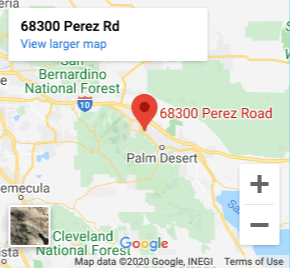Welcome to Davies Auto Care Inc.!
Turn to Davies Auto Care for all of your auto repairs & vehicle maintenance needs! Davies Auto Care is a full-service, preventive maintenance and auto repair center in the Palm Springs area, specializing in maintenance schedules, brakes, computer diagnostics, heating & cooling, transmission, smog and emissions since 1993.
Contact Davies Auto Care Inc. for Auto Air Conditioning Service, Auto Mechanic, Auto Repair, Auto Repair Shops, Brake Repair, Brake Service, Brakes, California Smog Check, Car Repair, Car Service, Check Engine Light, Mechanic, Oil Change, Smog Certification, Smog Check, Smog Check Stations, Tire Repair, Tire Shops, Transmission, and Transmission Repair. Proudly supporting the areas of Banning, Beaumont, Bermuda Dunes, Cathedral City, Cherry Valley, Coachella, Coachella Valley, Desert Hot Springs, Indian Wells, Indio, Joshua Tree, La Quinta, Moreno Valley, Morongo Valley, Palm Desert, Palm Springs, Rancho Mirage, Thousand Palms, Twentynine Palms, Yucca Valley, and surrounding areas.
Contact Davies Auto Care Inc. for?Auto Air Conditioning Service in Coachella Valley,?Auto Mechanic in Coachella Valley,?Auto Repair in Coachella Valley,?Auto Repair Shops in Coachella Valley,?Brake Repair in Coachella Valley,?Brake Service in Coachella Valley,?Brakes in Coachella Valley,?California Smog Check in Coachella Valley,?Car Repair in Coachella Valley,?Car Service in Coachella Valley,?Check Engine Light in Coachella Valley,?Mechanic in Coachella Valley,?Oil Change in Coachella Valley,?Smog Certification in Coachella Valley,?Smog Check in Coachella Valley,?Smog Check Stations in Coachella Valley,?Tire Repair in Coachella Valley,?Tire Shops in Coachella Valley,?Transmission in Coachella Valley,?Transmission Repair in Coachella Valley, and in surrounding areas.
Below is some general information about Coachella Valley:
Coachella Valley is a large valley landform in Southern California. The valley extends for approximately 45 miles (72 kilometers) in Riverside County southeast from the San Bernardino Mountains to the saltwater Salton Sea, the largest lake in California. It is approximately 15 miles (24 kilometers) wide along most of its length, bounded on the west by the San Jacinto Mountains and the Santa Rosa Mountains and on the north and east by the Little San Bernardino Mountains. The San Andreas Fault crosses the valley from the Chocolate Mountains in the southeast corner and along the centerline of the Little San Bernardinos. The fault is easily visible along its northern length as a strip of greenery against an otherwise bare mountain.
The Chocolate Mountains are home to a United States Navy live gunnery range and are mostly off-limits to the public. In comparison to the Inland Empire (IE) (Riverside-San Bernardino area and the California desert), some people refer to the IE?s sub-region Coachella Valley as the Desert Empire to differentiate it from the neighboring Imperial Valley. Geographers and geologists sometimes call the area, along with the Imperial Valley to the south, the Cahuilla Basin or the Salton Trough.
Geographically, it is the agricultural and recreational desert valley in Southern California, United States, east of Riverside and San Bernardino. Populated by nearly 600,000 people, the valley is part of the 13th largest metropolitan area in the United States, the Inland Empire. The famous desert resort cities of Palm Springs and Palm Desert lie in the Coachella Valley. The Coachella Valley is the second largest sub-region in the Inland Empire metropolitan area, after the Greater San Bernardino Area. It may be due to the number of seasonal residents in the winter months may surpassed the number of permanent residents in the total Riverside area.
The area is surrounded on the southwest by the Santa Rosa Mountains, by the San Jacinto Mountains to the west, the Little San Bernardino Mountains to the east and San Gorgonio Mountain to the north. These mountains peak at around 11,000 feet (3,400 meters) and tend to average between 5,000 to 7,000 feet (1,500 to 2,000 meters). Elevations on the Valley floor range from 1600 feet above sea level at the north end of the Valley to 250 feet below sea level around Mecca. Sometimes a weather system can come through one of the narrow passes, or up from the Gulf of California as Hurricane Kathleen did in September 1976. In the summer months daytime temperatures range from 104 degrees Fahrenheit (40 degrees Celsius) to 112 degrees Fahrenheit (44 degrees Celsius) and nighttime lows from 75 degrees Fahrenheit (24 degrees Celsius) to 86 degrees Fahrenheit (30 degrees Celsius). During winter, the daytime temperatures range from 68 degrees Fahrenheit (20 degrees Celsius) to 88 degrees Fahrenheit (31 degrees Celsius) and corresponding nights range from 46 degrees Fahrenheit (8 degrees Celsius) to 65 degrees Fahrenheit (18 degrees Celsius) making it a popular winter resort destination. Due to its warm year-round climate the region?s agricultural sector produces fruits such as mangoes, figs and dates.
The San Andreas Fault traverses the Valley?s east side. Because of this fault, the Valley has many hot springs. The Santa Rosa Mountains to the West are part of the Lake Elsinore Fault zone. The results of a prehistoric sturzstrom can be seen in Martinez Canyon. The Painted Canyons of Mecca feature smaller faults as well as Precambrian, Tertiary and Quaternary rock formations, unconformities, badlands and desert landforms. Seismic activity is what triggers earthquakes, a natural, but occasionally destructive phenomena in the Coachella Valley. Fault lines cause hot water springs or geysers to rise from the ground. These natural water sources made habitation and development possible in the otherwise inhospitable desert environment of the Coachella Valley. Major earthquakes have affected the Coachella Valley. For instance, the Landers Earthquake in 1992 caused some damage in the valley. An earthquake of local origin which caused considerable damage was the 1986 North Palm Springs earthquake, which registered at a magnitude of 6.0, injuring 29 people and destroying 51 homes.
Source:?Coachella Valley on Wikipedia






